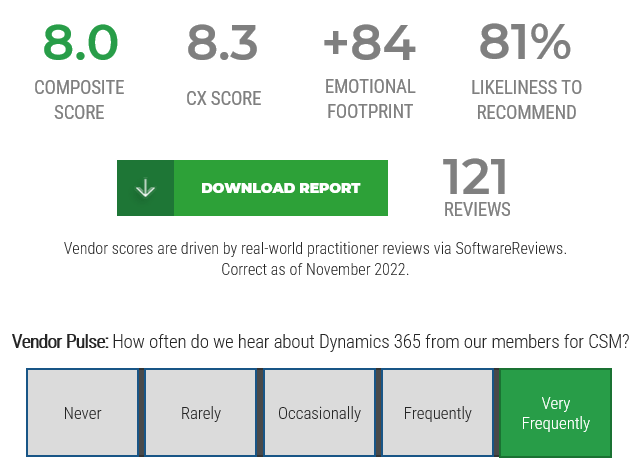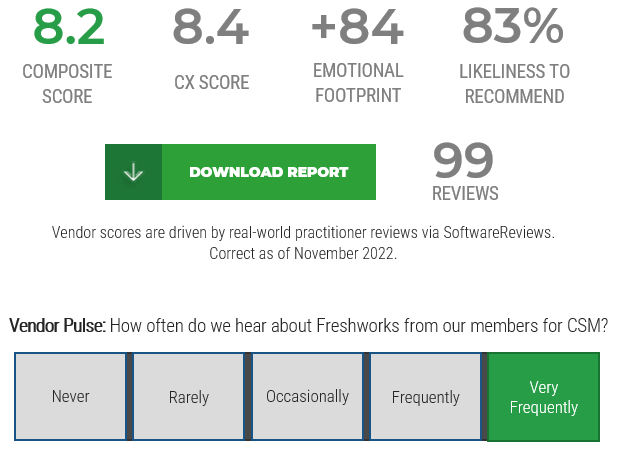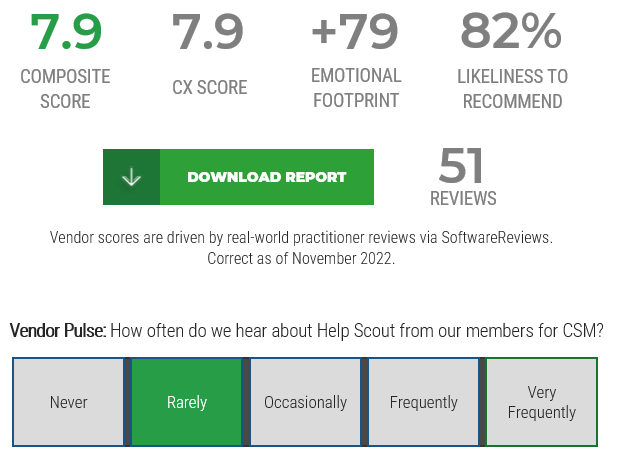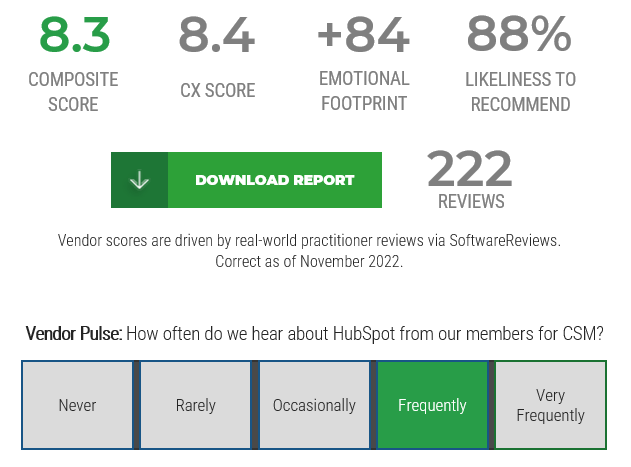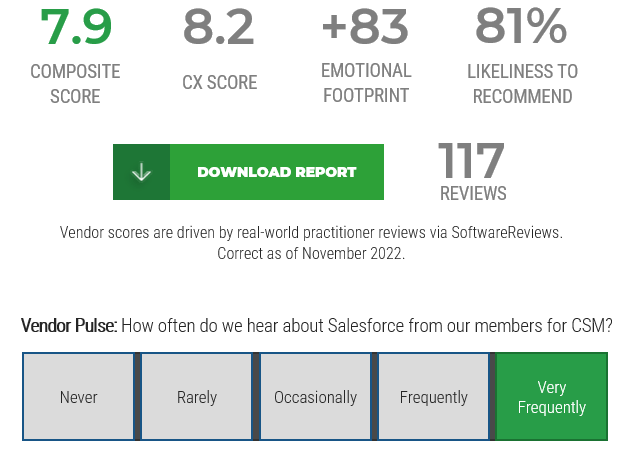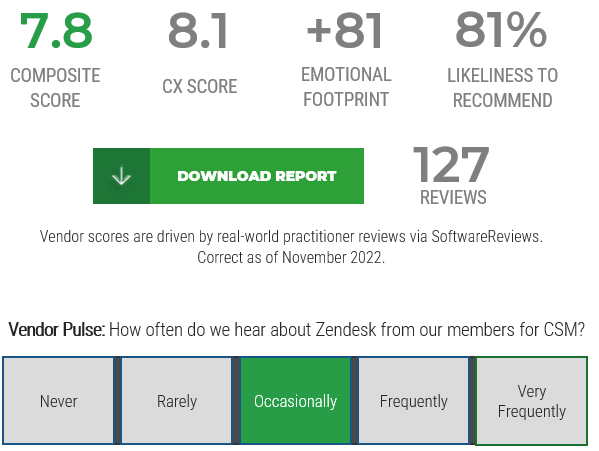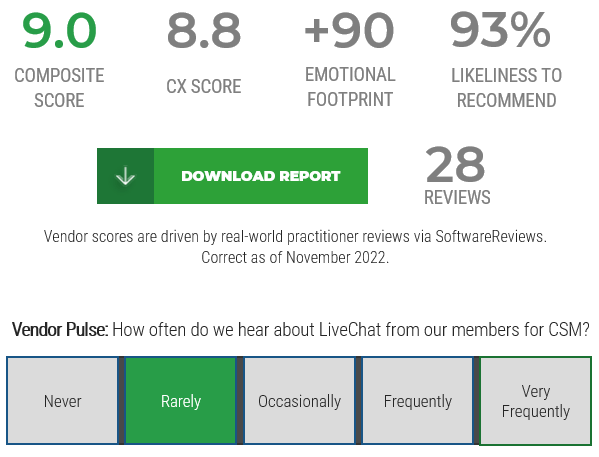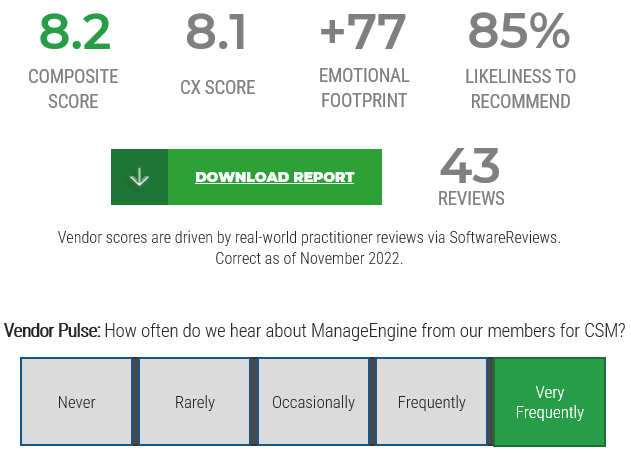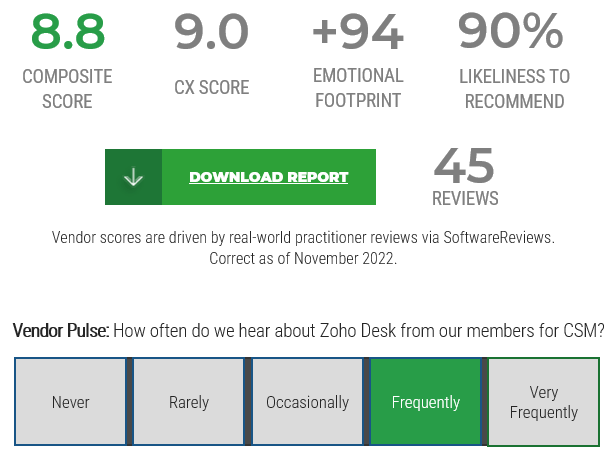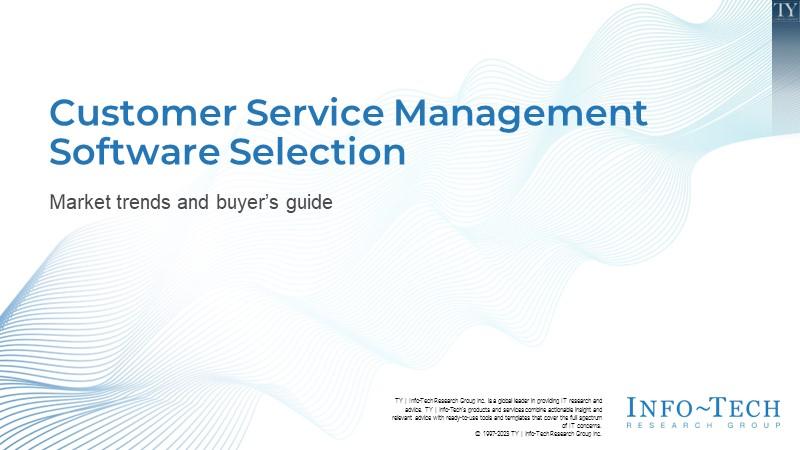
Customer Service Management Software Selection Guide
- The business is unaware of cross-selling opportunities across multiple product lines.
- Customer service staff attrition rates continue to be high, creating longer response delays for voice channels.
- Customer service responses are reactive in nature, reinforcing a poor culture for customer experience.
Our Advice
Critical Insight
- After-sales customer service is critical for creating, maintaining, and growing customer relationships. Organizations that fail to provide adequate service will be ill positioned for future customer service and sales efforts.
- Shift left toward delivering predictive service instead of reactive service to enhance customer experiences.
- Ensure your key performance indicators accurately reflect the incentives you want to give your customer support staff for delivering appropriate customer service.
Impact and Result
- Determine your organization’s customer service maturity (and thus if a standalone CSM tool is relevant).
- Understand key trends and differentiating features in the CSM marketspace.
- Evaluate major vendors in the CSM marketspace to discover the best-fitting provider.
Customer Service Management Software Selection Guide Research & Tools
Besides the small introduction, subscribers and consulting clients within this management domain have access to:
1. Customer Service Management Software Selection Guide – A guide to walk you through the process of selecting CSM software.
This trends and buyer’s guide will help you:
- Customer Service Management Software Selection Guide Storyboard
2. CSM Platform RFP Template – A template to provide vendors with a detailed account of the requirements and the expected capabilities of the desired suite.
Create your own request for proposal (RFP) for your customer service management suite procurement process by customizing Info-Tech's RFP template.
- CSM Platform RFP Template
3. CSM Platform Opportunity Assessment Tool – A tool to assess whether a CSM solution is right for your organization.
Use this tool to assess your maturity and fit for a CSM solution. It will help identify your current CSM state and assist with the decision to move forward with a new solution or augment certain features.
- CSM Platform Opportunity Assessment Tool
4. Software Selection Workbook – A workbook to document your progress as your select software.
Keep stakeholders engaged with simple and friction-free templates to document your progress for Rapid Application Selection.
- The Software Selection Workbook
5. Vendor Evaluation Workbook – A workbook to assess vendor capabilities and compare vendors.
Leverage a traceable and straightforward Vendor Evaluation Workbook to narrow the field of potential vendors and accelerate the application selection process.
- The Vendor Evaluation Workbook
6. CSM Platform RFP Scoring Tool – A tool to support your business in objectively evaluating the CSM vendors being considered for procurement.
Create an objective and fair scoring process to evaluate the RFPs and demonstrations provided by shortlisted vendors. Within this framework, provide a multidimensional evaluation that analyzes the solution's functional capabilities, architecture, costs, service support, and overall suitability in comparison to the organization's expressed requirements.
- CSM Platform RFP Scoring Tool
7. CSM Platform Vendor Demo Script Template – A template to support your business’ evaluation of vendors and their solutions with an effective demonstration.
Create an organized and streamlined vendor demonstration process by clearly outlining your expectations for the demo. Use the demo as an opportunity to ensure that capabilities expressed by vendors are actually present within the considered solution.
- CSM Platform Vendor Demo Script Template
Further reading
Customer Service Management Software Selection
Market trends and buyer’s guide
Analyst Perspective
The pandemic and growing younger demographic have shifted the terrain of customer service delivery. Customer service management (CSM) tools ensure organizations enhance customer acquisition, customer retention, and overall revenues into the future.
It is one thing to research customer service best practices; it is another to experience such service. Whether being put on hold for an hour with a telecommunications company, encountering voice biometric security with a bank, or receiving automated FAQs from a chatbot, we all perform our own primary research in customer service by going about our daily lives. Yet while the pandemic required a shift to this multichannel and digital assistant environment (to account for ongoing agent attrition), this trend was actually just accelerated. A growing younger demographic now prefers online communication channels to voice. Social media (whichever the platform) is a fundamental part of this demographic’s online presence and has instigated the need for customer service delivery to meet customers where they are – for both damage control and enhancing customer relationships.
Organizations delivering customer service across multiple product lines need to examine what delivery channels they need to satisfy customers, alongside assessing how customer loyalty and cross-selling can increase revenues and company reputation. Customer service management tools can assist and enable the future state.

Thomas Randall, Ph.D.
Research Director, Info-Tech Research Group
Executive Summary
| Your Challenge | Common Obstacles | Info-Tech’s Solution |
|
|
This trends and buyer’s guide will help you:
|
The objective at the end of the day is to have a single interface that the front-line staff interacts with. I think that is the holy grail when we look at CSM technology. The objective that everyone has in mind is we'd all like to get to one screen and one window. Ultimately, the end game really hasn't changed: How can we make it easy for the agents and how can we minimize their errors? How can we streamline the process so they can work?
Colin Taylor, CEO, The Taylor Reach Group
Customer service management tools form an integral part of your CXM technology portfolio
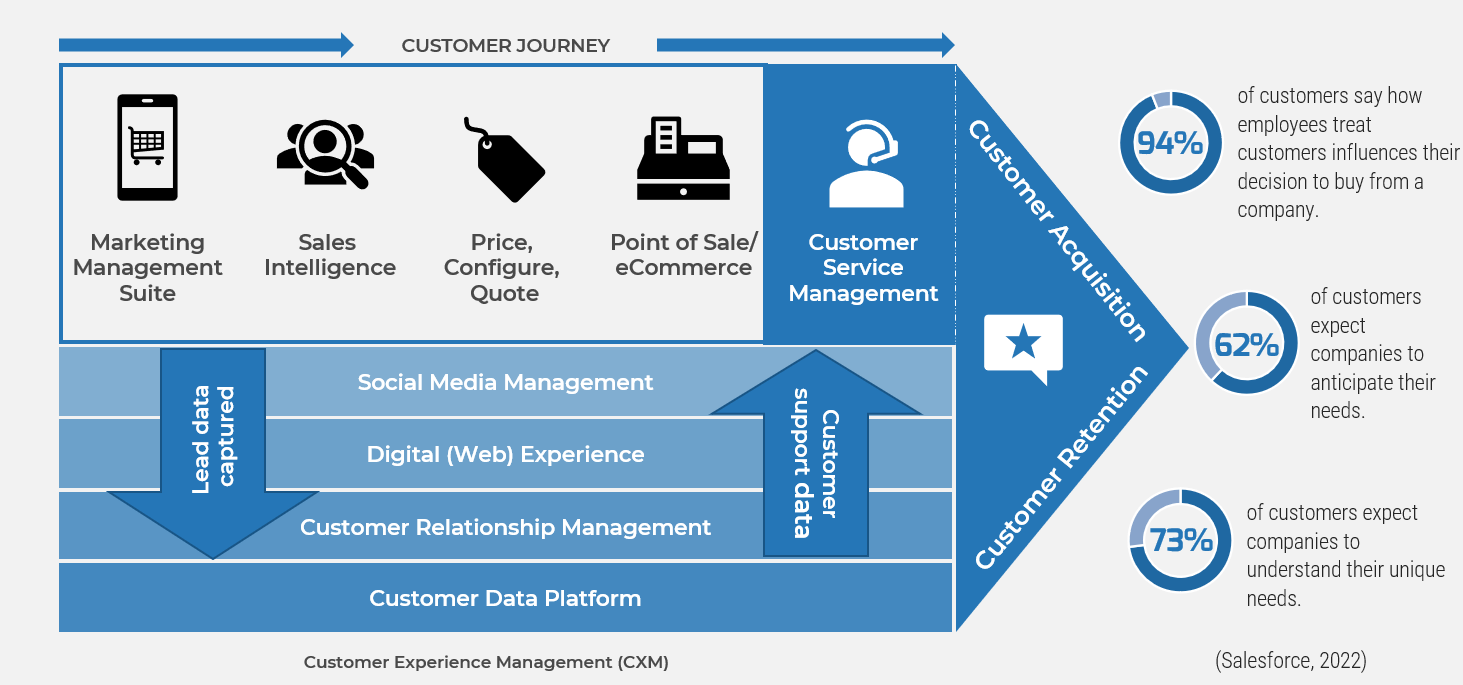
Info-Tech’s methodology for selecting the right CSM platform
| 1. Contextualize the CSM Landscape | 2. Select the Right CSM Vendor | |
|---|---|---|
| Phase Steps |
|
|
| Phase Outcomes |
|
|
Info-Tech Insight
Need help constructing your RFP? Use Info-Tech’s CSM Platform RFP Template!
Guided Implementation
What does a typical GI on this topic look like?
| Phase 1 | Phase 2 |
|---|---|
|
Call #1: Discover if CSM tools are right for your organization. Understand what a CSM platform is and discover the “art of the possible.” Call #2: Identify right-sized vendors and build the business case to select a CSM platform. |
Call #3: Define your key CSM requirements. Call #4: Build procurement items, such as an RFP and demo script. Call #5: Evaluate vendors and perform final due diligence. |
A Guided Implementation (GI) is a series of calls with an Info-Tech analyst to help implement our best practices in your organization.
The CSM selection process should be broken into segments:
- CSM vendor shortlisting with this buyer’s guide
- Structured approach to selection
- Contract review
Info-Tech offers various levels of support to best suit your needs
| DIY Toolkit | Guided Implementation | Workshop | Consulting |
|---|---|---|---|
| "Our team has already made this critical project a priority, and we have the time and capability, but some guidance along the way would be helpful." | "Our team knows that we need to fix a process, but we need assistance to determine where to focus. Some check-ins along the way would help keep us on track." | "We need to his the ground running and get this project kicked off immediately. Our team has the ability to take this over once we get a framework and strategy in place." | "Our team does not have the time or the knowledge to take this project on. We need assistance through the entirety of this project." |
Diagnostics and consistent frameworks are used throughout all four options
Software Selection Engagement
Five Advisory Calls Over a Five-Week Period to Accelerate Your Selection Process
Expert analyst guidance over five weeks on average to select and negotiate software
Save money, align stakeholders, speed up the process, and make better decisions
Use a repeatable, formal methodology to improve your application selection process
Better, faster results, guaranteed, included in membership
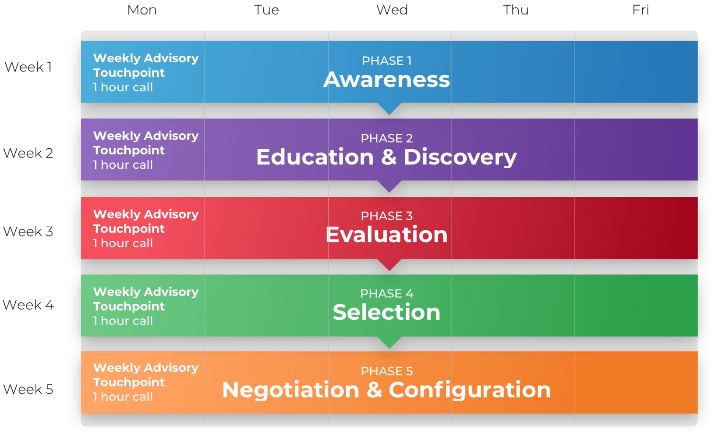
Software Selection Workshops
40 Hours of Advisory Assistance Delivered Online
Select Better Software, Faster
40 hours of expert analyst guidance
Project & stakeholder management assistance
Save money, align stakeholders, speed up the process, and make better decisions
Better, faster results, guaranteed, $25,000 standard engagement fee
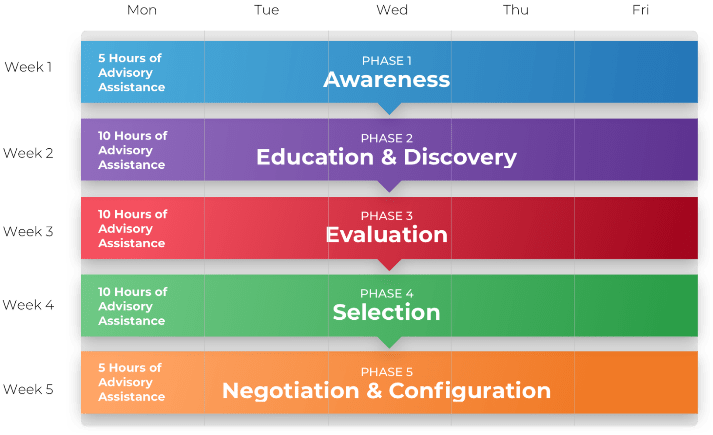
Customer Service Management (CSM) Software
Phase 1: Contextualize the CSM Landscape
Receive and resolve after-sales requests within a unified CSM platform
| MULTIPLE CHANNELS Customers may resolve their issues via a variety of channels, including voice, SMS, email, social media, and live webchat. |
KNOWLEDGE BASE Provide a knowledge base for FAQs that is both customer facing (via customer portal) and agent facing (for live resolutions). |
| ANALYTICS Track customer satisfaction, agent performances, ticket resolutions, backlogs, traffic analysis, and other key performance indicators (KPIs). |
COLLABORATION Enable agents to escalate and collaborate within a unified platform (e.g. tagging colleagues to flag a relevant customer query). |
Info-Tech Insight
After-sales customer service is critical for creating, maintaining, and growing customer relationships. Organizations that fail to provide adequate service will be poorly positioned for future customer service and sales efforts.
Identify your differentiating CSM requirements that align to your use cases
INTEGRATIONS
Note what integrations are available for your contact center, CRM, or industry-specific solutions (e.g. inventory management) to get the most out of CSM.
SENTIMENT ANALYSIS
Reads, contextualizes, and categorizes tickets by sentiment (e.g. “positive”) before escalating to an appropriate agent.
AUTO-RESPONSE EDITOR
Built-in AI provides prewritten responses or auto-pulls the relevant knowledge article, assisting agents with speed to resolution.
ATTRIBUTES-BASED ROUTING
Learns over time how best to route tickets to appropriate agents based on skills, availability, or proximity of an agent (e.g. multilingual, local, or specialist agents).
AUTOMATED WORKFLOWS
CSM tool providers have varying usability for workflow building and enablement. Ensure your use cases align.
TICKET PRIORITIZATION
Adapts and prioritizes customer issues by service-level agreement (SLA), priority, and severity according to inputted KPIs.
Good technology will not fix a bad process. I don't care how good the technology is. If the use case is wrong and the process is wrong, it's not going to work.
Colin Taylor, CEO
The Taylor Reach Group
Leverage CSM tools to shift left toward predictive customer service
| Real-time | Pre-event | Post-event | |
|---|---|---|---|
| Channel example: Notifications via SMS or social media. | Channel example: Notifications via SMS or social media. | Channel example: Working with an agent or live chatbot. | Channel example: Working with an agent or live chatbot. |
| “Your car may need a check-up for faulty parts.” | “Here is a local garage to fix your tire pressure.” | “I see you have poor tire pressure. Here is a local garage.” | “Thank you for your patience, how can we help?” |
| Predictive Service The CSM recommends mitigation options to the customer before the issue occurs and before the customer knows they need it. |
Proactive Service The issue occurs but the CSM recommends mitigation options to the customer before the customer contacts the organization. |
Real-Time Service The organization offers real-time mitigation options while working with the customer to resolve the issue. |
Reactive Service The customer approaches the organization after the issue occurs, but the organization has no insight into the event. |
Selecting a CSM tool should form part of your broader CXM strategy
Organizations should ask whether they need a standalone CSM solution or a CSM as part of a broader suite of CXM tools. The latter is especially relevant if your organization already invests in a CXM platform.
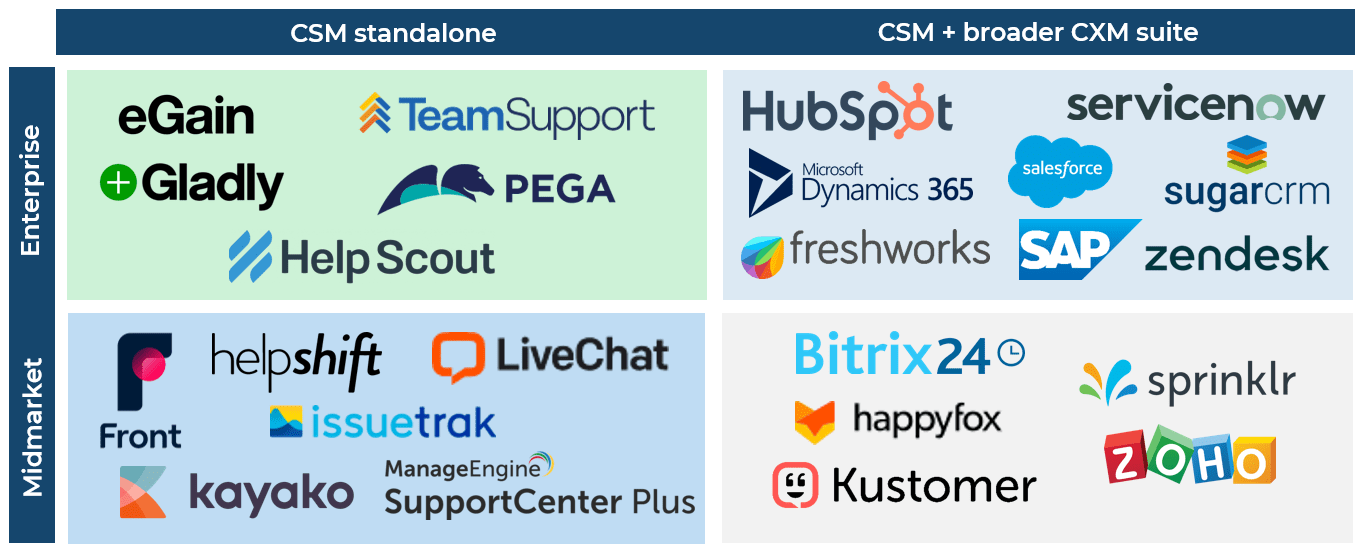
CSM tools are best-suited for organizations with high product and service complexity
Customer Service Complexity
Low complexity refers to primarily transactional inquiries. High complexity refers to service workflows for symptom analysis, problem identification, and solution delivery.
Product Complexity
High complexity refers to having a large number of brands and individual SKUs, technologically complex products, and products with many add-ons.

Info-Tech Insight
Use Info-Tech’s CSM Platform Opportunity Assessment Tool to discover your organization’s customer service maturity.
Activity: Discover your customer service maturity
30 minutes
- Complete the CSM Platform Opportunity Assessment Tool.
- Evaluate your result and document whether a CSM business case is warranted (or if a separate technology selection process is needed).
| Input | Output |
|---|---|
|
|
| Materials | Participants |
|
|
Download the CSM Platform Opportunity Assessment Tool
Finalize whether your organization is well positioned to leverage CSM tools
| Bypass | Adopt |
|---|---|
| Monochannel approach You do not participate in multichannel campaigns or your customer personas are typically limited to one or two channels (e.g. voice or SMS). |
Multichannel approach You are pursuing multifaceted, customer-specific campaigns across a multitude of channels. |
| Small to mid-sized business with small CX team Do not buy what you do not need. Focus on the foundations of customer experience (CX) first before extending into a full-fledged CSM tool. |
Maturing CX department Customer service needs are extending into managing budgets, generating and segmenting leads, and measuring channel effectiveness. |
| Limited product range CSM tools typically gain return on investment (ROI) if the organization has a complex product range and is looking to increase cross-sell opportunities across different customer personas. |
Multiple product lines Customer base and product lines are large enough to engage in opportunities for cross- and up-selling. |
Case Study
AkzoNobel
INDUSTRY
Retail
SOURCE
Sprinklr (2021)
Use CSM tools to unify the multichannel experience and reduce response time.
| Challenge | Solution | Results |
| AzkoNobel is a leading global paints and coatings company. AzkoNobel had 60+ fragmented customer service accounts on social media for multiple brands. There was little consistency in customer experience and agent responses. Moreover, the customer journey was not being tracked, resulting in lost opportunities for cross-selling across brands. The result: slow response times (up to one week) and unsatisfied customers, leaving the AzkoNobel brand in a vulnerable state. |
AkzoNobel leveraged Sprinklr, a customer experience software provider, to unify six social channels, 19 accounts, and six brands. Sprinklr aligned governance across social media channels with AzkoNobel’s strategic business goals, emphasizing the need for process, increasing revenue, and streamlining customer service. AzkoNobel was able to use keywords from customers’ inbound messaging to put an escalation process in place. |
Since bringing on Sprinklr in 2015-2016, unifying customer service channels under one multichannel platform resulted in:
|
How it got here: The birth of CSM tools
CSM developed alongside the telephone and call center, rather than customer relationship management platforms.
| 1920s | 1950s | 1967-1973 | 1980-1990s | 2000-2010s |
|---|---|---|---|---|
| The introduction of lines of credit and growth of household appliance innovations meant households were buying products at an unprecedented rate. Department stores would set up customer service sections to assist with live fixes or returns. | Following the Great Depression and World War II, process, efficiency, and computational technology became defining features of customer service. These features were played out in call centers as automatic call distribution (ACD) technology began to scale. | With the development of private automatic branch exchange (PABX), AT&T introduced the toll-free telephone number. Companies began training staff and departments for customer service and building loyalty. With the development of interactive voice response (IVR) in 1973, call centers became increasingly more efficient at routing. | Analog technology shifted to digital and the term “contact center” was coined. These centers began being outsourced internationally. With the advent of the internet, CSM technology (in the early guise of a “help desk”) became equipped with computer telephony integration (CTI). | Software as a service (SaaS) and CRM maturation strengthened the retention and organization of customer data. Social media also enhanced consumer power as companies rushed to prevent online embarrassment. This prompted investment in multichannel customer service. |
Where it’s going: The future of CSM tools lies in predictive analytics
The capabilities below are available today but will mature over the next few years. Use the roadmap as a guide for your year of implementation.
2023
Go mobile first
85% of customers believe a company’s mobile website should be just as good as its desktop website. Enabling user-friendly mobile websites provides an effective channel to keep inbound calls down.
2024
Shift from multichannel to omnichannel
Integrating CSM tools with your broader CXM suite enables customer data to seamlessly travel between channels for an omnichannel experience.
2025
Enable predictive service
CSM tools integrate with Internet of Things (IoT) systems to provide automated notifications that alert staff of issues and mitigate issues with customers before the issue even occurs.
2026
Leverage predictive analytics for ML use cases
Use customers’ historic data and preferences to perform better automated customer service over time (e.g. providing personalized resolutions based on previous customer engagements).
Context and scenario play a huge role in measuring good customer service. Ensure your KPIs accurately reflect the incentives you want to give your customer support staff for delivering appropriate customer service.
David Thomas, Customer Service Specialist
Freedom Mobile
(Reve Chat, 2022)
Key trends in CSM technology
As predictive analytics matures, organizations are making use of CSM tools’ ability to enhance personalization, improve their social media response times, and enable self-service.
BIOMETRICS
65% of customers say they would accept voice recognition to authorize their identity when calling a customer support line (GetApp, 2021).
PERSONALIZATION
51% of marketers, advocating for personalization across multiple touchpoints saw 300% ROI (KoMarketing, 2020).
SOCIAL MEDIA
29% of customers aged 18 to 39 prefer online chat communication before and after purchase (RingCentral, 2020).
SELF-SERVICE
92% of customers say they would use a knowledge base for self-service support if it was available (Vanilla, 2020).
Customer Service Management (CSM) Software
Phase 2: Select the Right CSM Vendor
Conduct a business impact assessment to document the case for CSM tool selection
Business Opportunity
Determine high-level understanding of the need that must be addressed, along with the project goals and affiliated key metrics. Establish KPIs to measure project success.
System Diagram
Determine the impact on the application portfolio and where integration is necessary.
Risks
Identify potential blockers and risk factors that will impede selection.
High-Level Requirements
Consider the business functions and processes affected.
People Impact
Confirm who will be affected by the output of the technology selection.
Overall Business Case
Calculate the ROI and the financial implications of the application selection. Highlight the overarching value.
Activity: Build the business case
2 hours
- Access the Business Impact Assessment within the Software Selection Workbook (linked below). Store the assessment in a shared folder (such as in SharePoint, OneDrive, or Google Drive).
- Set aside two hours (does not need to be all at once) to ensure the selection team aligns with the unifying rationale for selection.
- Complete the six steps to arrive at a high-level business case. This case can then be shared and communicated with interested parties (e.g. impacted stakeholders).
| Input | Output |
|---|---|
|
|
| Materials | Participants |
|
|
Download the Software Selection Workbook
Elicit and prioritize granular requirements for your CSM platform
Understanding business needs through requirements gathering is key to defining everything about what is being purchased, yet it is an area where people often make critical mistakes.
| Signs of poorly scoped requirements | Best practices |
|---|---|
|
|
Info-Tech Insight
Review Info-Tech’s requirements gathering methodology to improve your requirements gathering process.
Choose your route: RFP or otherwise?
As you gather requirements, decide which procurement route best suits your context.
| RFI (Request for Information) | RFQ (Request for Quotation) | RFP (Request for Proposal) | |
|---|---|---|---|
| Purpose and Usage |
Gather information about products/services when you know little about what’s available. Often followed by an RFP. |
Solicit pricing and delivery information for products/services with clearly defined requirements.
Best for standard or commodity products/services. |
Solicit formal proposals from vendors to conduct an evaluation and selection process. Formal and fair process; identical for each participating vendor. |
| Level of Intent |
Fact-finding – there is no commitment to engage the vendor. Vendors are often reluctant to provide quotes. |
Committed to procure a specific product/service at the lowest price. |
Intent to buy the products/services in the RFP. Business case/approval to spend is already obtained. |
| Level of Detail | High-level requirements and business goals. |
Detailed specifications of what products/services are needed. Detailed contract and delivery terms. |
Detailed business requirements and objectives. Standard questions and contract term requests for all vendors. |
| Response |
Generalized response with high-level product/services. Sometimes standard pricing quote. |
Price quote and confirmation of ability to fulfill desired terms. |
Detailed solution description, delivery approach, customized price quote, and additional requested information. Product demo and/or hands-on trial. |
Info-Tech Insight
If you are in a hurry, consider instead issuing Info-Tech’s Vendor Evaluation Workbook. This workbook speeds up the typical procurement process by adding RFP-like requirements (such as operational and technical requirements) while driving the procurement process via emphasis on high-value use cases.
Download the Vendor Evaluation Workbook
Activity: Document requirements
2 hours
- Review each tab of Info-Tech’s CSM Platform RFP Scoring Tool to generate use cases and ideas for your requirements building.
- Modify and include additional features you may need, using Info-Tech’s CSM Platform RFP Template to assist with structure (if pursuing an RFP process) or Vendor Evaluation Workbook (if an RFP process is not needed). Pay attention to any nonfunctional requirements (such as security or integrations), alongside future trends of CSM. Vendors must be able to scale with your organization’s growth.
- You can use the CSM Platform RFP Scoring Tool again when assessing vendor responses.
| Input | Output |
|---|---|
|
|
| Materials | Participants |
|
|
Download the CSM Platform RFP Scoring Tool
Download the CSM Platform RFP Template
Once vendor responses are in, turn product demos into investigative interviews
Avoid vendor glitz and glamour shows by ensuring vendors are concretely applying their solution to your high-value use cases.
| 1 | Minimize the number of vendors to four to keep up the pace of the selection process. |
| 2 | Provide a demo script that captures your high-value use cases and differentiating requirements. |
| 3 | Ensure demos are booked close together and the selection committee attends all demos. |
Conduct a day of rapid-fire vendor demos
Zoom in on high-value use cases and answers to targeted questions
Rapid-fire vendor investigative interview
Invite vendors to come onsite (or join you via videoconference) to demonstrate the product and answer questions. Use a highly targeted demo script to help identify how a vendor’s solution will fit your organization’s particular business capability needs.
Give each vendor 90 to 120 minutes to give a rapid-fire presentation. We suggest the following structure:
- 30 minutes: Company introduction and vision
- 60 minutes: Walkthrough of two or three high-value demo scenarios
- 30 minutes: Targeted Q&A from the business stakeholders and procurement team
To ensure a consistent evaluation, vendors should be asked analogous questions and answers should be tabulated.
How to challenge the vendors in the investigative interview
- Change the visualization/presentation.
- Change the underlying data.
- Add additional data sets to the artifacts.
- Test voice quality (if the vendor offers a native telephony channel).
- Test collaboration capabilities.
To kick-start scripting your demo scenarios, leverage our CSM Platform Vendor Demo Script Template.
A vendor scoring model provides a clear anchor point for your evaluation of CRM vendors based on a variety of inputs
A vendor scoring model is a systematic method for effectively assessing competing vendors. A weighted-average scoring model is an approach that strikes a strong balance between rigor and evaluation speed.
| How do I build a scoring model? | What are some of the best practices? |
|---|---|
|
|
Info-Tech Insight
Even the best scoring model will still involve some “art” rather than science. Scoring categories such as vendor viability always entail a degree of subjective interpretation.
Define how you will score vendor responses and demos
Your key CSM criteria should be informed by the following goals, use cases, and requirements.
| Criteria | Description |
|---|---|
| Functional Capabilities | How well does the vendor align with the top-priority functional requirements identified in your accelerated needs assessment? What is the vendor’s functional breadth and depth? |
| Affordability | How affordable is this vendor? Consider a three-to-five-year total cost of ownership (TCO) that encompasses not just licensing costs but also implementation, integration, training, and ongoing support costs. |
| Architectural Fit | How well does this vendor align with your direction from an enterprise architecture perspective? How interoperable is the solution with existing applications in your technology stack? Does the solution meet your deployment model preferences? |
| Extensibility | How easy is it to augment the base solution with native or third-party add-ons as your business needs may evolve? |
| Scalability | How easy is it to expand the solution to support increased user, data, and/or customer volumes? Does the solution have any capacity constraints? |
| Vendor Viability | How viable is this vendor? Are they an established player with a proven track record or a new and untested entrant to the market? What is the financial health of the vendor? How committed are they to the particular solution category? |
| Vendor Vision | Does the vendor have a cogent and realistic product roadmap? Are they making sensible investments that align with your organization’s internal direction? |
| Emotional Footprint | How well does the vendor’s organizational culture and team dynamics align to yours? |
| Third-Party Assessments and/or References | How well-received is the vendor by unbiased third-party sources like SoftwareReviews? For larger projects, how well does the vendor perform in reference checks (and how closely do those references mirror your own situation)? |
Leverage Info-Tech’s Contract Review Services to level the playing field with shortlisted vendors
You may be faced with multiple products, services, master service agreements, licensing models, service agreements, and more.
Use Info-Tech’s Contract Review Services to gain insights on your agreements.
Consider the aspects of a contract review:
- Are all key terms included?
- Are they applicable to your business?
- Can you trust that results will be delivered?
- What questions should you be asking from an IT perspective?
Validate that a contract meets IT’s and the business’ needs by looking beyond the legal terminology. Use a practical set of questions, rules, and guidance to improve your value for dollar spent.
Download Master Contract Review and Negotiation for Software Agreements
Customer Service Management (CSM) Software
Vendor Analysis
Evaluate software category leaders through vendor rankings and awards
SoftwareReviews
The Data Quadrant is a thorough evaluation and ranking of all software in an individual category to compare platforms across multiple dimensions.
Vendors are ranked by their Composite Score, based on individual feature evaluations, user satisfaction rankings, vendor capability comparisons, and likeliness to recommend the platform.
The Emotional Footprint is a powerful indicator of overall user sentiment toward the relationship with the vendor, capturing data across five dimensions.
Vendors are ranked by their Customer Experience (CX) Score, which combines the overall Emotional Footprint rating with a measure of the value delivered by the solution.
Speak with category experts to dive deeper into the vendor landscape
SoftwareReviews
Fact-based reviews of business software from IT professionals.
Product and category reports with state-of-the-art data visualization.
Top-tier data quality backed by a rigorous quality assurance process.
User-experience insight that reveals the intangibles of working with a vendor.
SoftwareReviews is powered by Info-Tech
Technology coverage is a priority for Info-Tech, and SoftwareReviews provides the most comprehensive, unbiased data on today’s technology. Combined with the insight of our expert analysts, our members receive unparalleled support in their buying journey.
Click here to access SoftwareReviews
Comprehensive software reviews to make better IT decisions
We collect and analyze the most detailed reviews on enterprise software from real users to give you an unprecedented view into the product and vendor before you buy.
Microsoft Dynamics 365
Est. 2003 | WA, USA | MSFT:NASDAQ
Bio
To accelerate your digital transformation, you need a new type of business application. One that breaks down the silos between CRM and ERP, that’s powered by data and intelligence, and helps capture new business opportunities. That’s Microsoft Dynamics 365.
Offices
Microsoft is located all over the world. For a full list, see Microsoft Worldwide Sites.
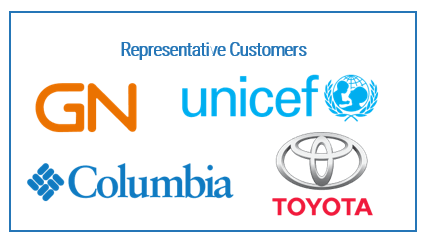
Stated Industry Specializations
- Covers an extremely wide range of industries, such as finance, education, government, healthcare, manufacturing, and retail.
SoftwareReviews’ CSM Enterprise Vendor Ranking
(out of 7)
Likeliness to Recommend
- 7th (81%)
Plan to Renew
- 6th (93%)
Satisfaction That Cost Is Fair Relative to Value
- 2nd (81%)
Strengths
- Product Strategy and Rate of Improvement (1st)
- Ease of Customization (1st)
- Breadth of Features (2nd)
Areas to Improve
- Availability and Quality of Training (5th)
- Ease of Implementation (7th)
- Usability and Intuitiveness (7th
Microsoft Dynamics 365
History
Founded 2003 (as Microsoft Dynamics CRM)
2005 Second version branded Dynamics 3.0.
2009 Dynamics CRM 4.0 (Titan) passes 1 million user mark.
2015 Announces availability of CRM Cloud design for FedRAMP compliance.
2016 Dynamics 365 released as successor to Dynamics CRM.
2016 Microsoft’s acquisition of LinkedIn provides line of data to 500 million users.
2021 First-party voice channel added to Dynamics 365.
2022 Announces Digital Contact Center Platform powered with Nuance AI, MS Teams, and Dynamics 365.
Microsoft is rapidly innovating in the customer experience technology marketspace. Alongside Dynamics 365’s omnichannel offering, Microsoft is building out its own native contact center platform. This will provide new opportunities for centralization without multivendor management between Dynamics 365, Microsoft Teams, and an additional third-party telephony or contact-center-as-a-service (CCaaS) vendor. SoftwareReviews reports suggest that Microsoft is a market leader in the area of product innovation for CSM, and this area of voice channel capability is where I see most industry interest.
Of course, Dynamics 365 is not a platform to get only for CSM functionality. Users will typically be a strong Microsoft shop already (using Dynamics 365 for customer relationship management) and are looking for native CSM features to enhance customer service workflow management and self-service.
Thomas Randall
Research Director, Info-Tech Research Group
Info-Tech Insight
Pricing for Microsoft Dynamics 365 is often contextualized to an organization’s needs. However, this can create complicated licensing structures. Two Info-Tech resources to assist are:
- Modernize Your Microsoft Licensing for the Cloud Era (research blueprint)
- Vendor Contract and Cost Optimization (benchmarking and review service*)
*This service may be used for other enterprise CSM providers too, including Salesforce, ServiceNow, SAP, and Oracle.
Contact your account manager to review your access to this service.
Freshworks
Est. 2010 | CA, USA | FRSH:NASDAQ
Bio
Freshworks' cloud-based customer support software, Freshdesk, makes customer happiness refreshingly easy. With powerful features, an easy-to-use interface, and a freemium pricing model, Freshdesk enables companies of all sizes to provide a seamless multichannel support experience across email, phone, web, chat, forums, social media, and mobile apps. Freshdesk’s capabilities include robust ticketing, SLA management, smart automations, intelligent reporting, and game mechanics to motivate agents.
Offices
- Americas: US
- Asia-Pacific (APAC): Australia, India, Singapore
- Europe, Middle East, and Africa (EMEA): France, Germany, Netherlands, UK
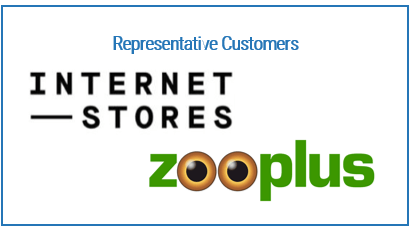
Stated Industry Specializations
- Automotive
- Education
- Energy
- Finance
- Healthcare
- Nonprofit
- Professional Services
- Publishing
- Real Estate
- Retail
- Travel
SoftwareReviews’ CSM Enterprise Vendor Ranking
(out of 7)
Likeliness to Recommend
- 3rd (83%)
Plan to Renew
- 4th (94%)
Satisfaction That Cost Is Fair Relative to Value
- 3rd (80%)
Strengths
- Breadth of Features (1st)
- Usability and Intuitiveness (1st)
- Ease of Implementation (2nd)
Areas to Improve
- Ease of IT Administration (3rd)
- Vendor Support (4th)
- Product Strategy and Rate of Improvement (4th)
Freshworks
History
Founded 2010
2011 Freshdesk forms a core component of product line.
2014 Raises significant capital in Series D round: $31M.
2016 Acquires Airwoot, enabling real-time customer support on social media.
2019 Raises $150M in Series H funding round.
2019 Acquires Natero, which predicts, analyzes, and drives customer behavior.
2021 Surpasses $300M in annual recurring revenues.
2021 Freshworks posts its IPO listing.
Freshworks stepped into the SaaS customer support marketspace in 2010 to attract dissatisfied Zendesk eSupport customers, following Zendesk’s large price increases that year (of 300%). After performing well during the pandemic, Freshworks has reinforced its global positioning in the CSM tool marketspace; SoftwareReviews data suggests Freshworks performs very well against its competitors for breadth and intuitiveness of its features.
Freshworks receives strong recommendations from Info-Tech’s members, boasting a broad product selection that enables opportunities for scaling and receiving a high rate of value return. Of note are Freshworks’ internal customer management solution and its native contact center offering, limiting multivendor management typically required for integrating separate IT service management (ITSM) and CCaaS solutions.
Thomas Randall
Research Director, Info-Tech Research Group
| Free | Growth | Pro | Enterprise |
|---|---|---|---|
|
|
|
|
*Pricing correct as of November 2022. Listed in USD and absent discounts.
See pricing on vendor’s website for latest information.
Help Scout
Est. 2006 | MA, USA | HUBS:NYSE
Bio
Help Scout is designed with your customers in mind. Provide email and live chat with a personal touch and deliver help content right where your customers need it, all in one place, all for one low price. The customer experience is simple and training staff is painless, but Help Scout still has all the powerful features you need to provide great support at scale. With best-in-class reporting, an integrated knowledge base, 50+ integrations, and a robust API, Help Scout lets your team focus on what really matters: your customers.
Offices
- Americas: Canada, Colombia, US
- APAC: Australia, Japan, Singapore
- EMEA: Belgium, France, Ireland, Germany, UK
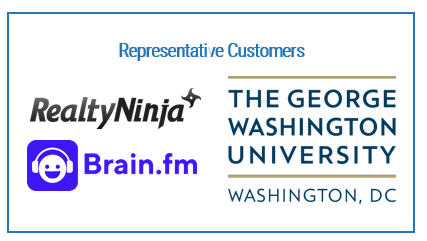
Stated Industry Specializations
- eCommerce
- Education
- Finance
- Healthcare
- Logistics
- Manufacturing
- Media
- Professional Services
- Property Management
- Software
SoftwareReviews’ CSM Enterprise Vendor Ranking
(out of 7)
Likeliness to Recommend
- 4th (82%)
Plan to Renew
- 7th (87%)
Satisfaction That Cost Is Fair Relative to Value
- 7th (71%)
Strengths
- Business Value Created (1st)
- Ease of Data Integration (1st)
- Breadth of Features (3rd)
Areas to Improve
- Ease of IT Administration (5th)
- Product Strategy and Rate of Improvement (5th)
- Quality of Features (6th)
Help Scout
History
Founded 2011
2015 Raised $6M in Series A funding.
2015 Rebrands from Brightwurks to Help Scout.
2015 Named by Appstorm as one of six CSM tools to delight Mac users.
2016 iOS app released.
2017 Android app released.
2020 All employees instructed to work remotely.
2021 Raises $15M in Series B funding.
Help Scout provides a simplified, standalone CSM tool that operates like a shared email inbox. Best suited for mid-sized organizations, customers can expect live chat, in-app messaging, and knowledge-base functionality. A particular strength is Help Scout’s integration capabilities, with a wide range of CRM, eCommerce, marketing, and communication APIs available. This strength is also reflected in the data: SoftwareReviews lists Help Scout as first in its CSM category for ease of data integrations.
Customers who are expecting a broader range of channels (including voice, video cobrowsing, and so on) will not find good return on investment with Help Scout. However, for mid-sized organizations looking to begin maturing their customer service management, Help Scout provides a strong foundation – especially for enhancing in-house collaboration between support staff.
Thomas Randall
Research Director, Info-Tech Research Group
| Standard | Plus | Pro |
|---|---|---|
|
|
|
*Pricing correct as of November 2022. Listed in USD and absent discounts.
See pricing on vendor’s website for latest information.
HubSpot
Est. 2006 | MA, USA | HUBS:NYSE
Bio
HubSpot’s Service Hub brings all your customer service data and channels together in one place and helps scale your support through automation and self-service. The result? More time for proactive service that delights, retains, and grows your customer base. HubSpot provides software and support to help businesses grow better. The overall platform includes marketing, sales, service, and website management products that start free and scale to meet our customers’ needs at any stage of growth.
Offices
- Americas: Canada, Colombia, US
- APAC: Australia, Japan, Singapore
- EMEA: Belgium, France, Ireland, Germany, UK
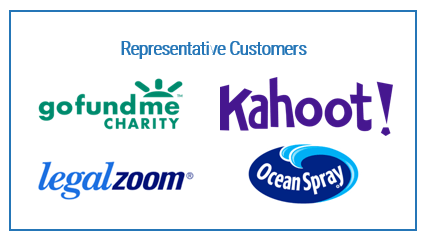
Stated Industry Specializations
- Covers an extremely wide range of industries, such as finance, education, healthcare, manufacturing, and retail.
SoftwareReviews’ CSM Enterprise Vendor Ranking
(out of 7)
Likeliness to Recommend
- 1st (88%)
Plan to Renew
- 1st (98%)
Satisfaction That Cost Is Fair Relative to Value
- 5th (78%)
Strengths:
- Vendor Support (1st)
- Availability and Quality of Training (1st)
- Ease of IT Administration (1st)
Areas to Improve:
- Ease of Data Integration (5th)
- Ease of Customization (5th)
- Breadth of Features (7th)
HubSpot
History
Founded 2006
2013 Opens first international office in Ireland.
2014 First IPO listing on NYSE, raising $140M.
2015 Milestone for acquiring 15,000 customers
2017 Acquires Kemvi for AI and ML support for sales teams.
2019 Acquires PieSync for customer data synchronization.
2021 Yamini Rangan is announced as new CEO.
2021 Records $1B in revenues.
HubSpot is a competitive player in the enterprise sales and marketing technology market. Offering an all-in-one platform, HubSpot allows users to leverage its CRM, marketing solutions, content management tool, and CSM tool. Across knowledge management, contact center integration, and customer self-service, SoftwareReviews data pits HubSpot as performing better than its enterprise competitors.
While customers can leverage HubSpot’s CSM tool independently, watch out for scope creep. HubSpot’s other offerings are tightly integrated and module extensions could quickly add up in price. HubSpot may not be affordable for most regional, mid-sized organizations, and a poor ROI may be expected. For instance, the Pro plan is required to get a knowledge base, which is typically a standard CSM feature – yet the same plan also comes with multicurrency support, which could remain unleveraged.
Thomas Randall
Research Director, Info-Tech Research Group
| Free | Starter | Pro | Enterprise |
|---|---|---|---|
|
|
|
|
*Pricing correct as of November 2022. Listed in USD and absent discounts.
See pricing on vendor’s website for latest information.
Salesforce
Est. 1999 | CA, USA | CRM:NYSE
Bio
Service Cloud customer service software gives you faster, smarter customer support. Salesforce provides customer relationship management software and applications focused on sales, customer service, marketing automation, analytics, and application development.
Offices
- Americas: US
- APAC: Australia, India, Singapore
- EMEA: France, Germany, Netherlands, UK
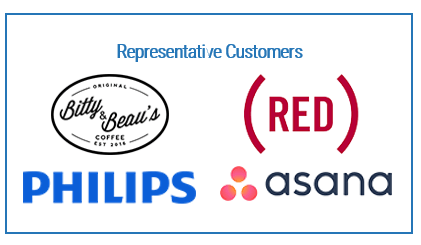
Stated Industry Specializations
- Covers an extremely wide range of industries, such as finance, education, government, healthcare, manufacturing, and retail.
SoftwareReviews’ CSM Enterprise Vendor Ranking
(out of 7)
Likeliness to Recommend
- 6th (81%)
Plan to Renew
- 2nd (96%)
Satisfaction That Cost Is Fair Relative to Value
- 4th (79%)
Strengths:
- Usability and Intuitiveness (5th)
- Breadth of Features (5th)
- Ease of Implementation (6th)
Areas to Improve:
- Ease of IT Administration (7th)
- Availability and Quality of Training (7th)
- Ease of Customization (7th)
Salesforce
History
Founded 1999
2000 Salesforce launches its cloud-based products.
2003 The first Dreamforce (a leading CX conference) happens.
2005 Salesforce unveils AppExchange.
2013 Salesforce acquires ExactTarget and expands Marketing Cloud offering.
2016 Salesforce acquires Demandware, launches Commerce Cloud.
2019 Salesforce acquires Tableau to expand business intelligence capabilities.
2021 Salesforce buys major collaboration vendor Slack.
Salesforce was an early disruptor in CRM marketspace, placing a strong emphasis on a SaaS delivery model and end-user experience. This allowed Salesforce to rapidly gain market share at the expense of complacent enterprise application vendors. A series of savvy acquisitions over the years has allowed Salesforce to augment its core Sales and Service Clouds with a wide variety of other solutions, from ecommerce to marketing automation – and recently Slack for internal collaboration.
Salesforce Service Cloud Voice is now available to take advantage of integrating telephony and voice channels into your CRM. This service is still maturing, though, with Salesforce selecting Amazon Connect as its preferred integrator. However, Connect is not necessarily plug-and-play – it is a communications platform as a service, requiring you to build your own contact center solution. This is either a fantastic opportunity for creativity or a time suck of already tied-up resources.
Thomas Randall
Research Director, Info-Tech Research Group
| Service Cloud Essentials | Service Cloud Professional | Service Cloud Enterprise | Service Cloud Unlimited |
|---|---|---|---|
|
|
|
|
*Pricing correct as of November 2022. Listed in USD and absent discounts.
See pricing on vendor’s website for latest information.
Zendesk
Est. 2007 | CA, USA | ZEN:NYSE
Bio
Zendesk streamlines your support with time-saving tools like ticket views, triggers, and automations. This helps you get straight to what matters most – better customer service and more meaningful conversations. Today, Zendesk is the champion of great service everywhere for everyone and powers billions of conversations, connecting more than 100,000 brands with hundreds of millions of customers over telephony, chat, email, messaging, social channels, communities, review sites, and help centers.
Offices
- Americas: Brazil, Canada, US
- APAC: Australia, China, India, Indonesia, Japan, Korea, Malaysia, Philippines, Singapore, Thailand, Vietnam
- EMEA: Denmark, France, Germany, Ireland, Italy, Netherlands, Poland, Spain, Sweden, UK
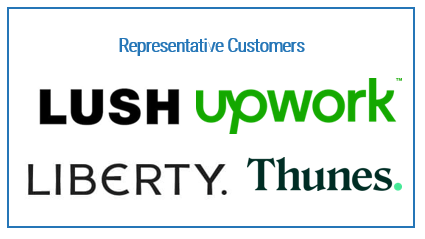
Stated Industry Specializations
- Education
- Finance
- Government
- Healthcare
- Manufacturing
- Media
- Retail
- Software
- Telecommunications
SoftwareReviews’ CSM Enterprise Vendor Ranking
(out of 7)
Likeliness to Recommend
- 5th (81%)
Plan to Renew
- 5th (94%)
Satisfaction That Cost Is Fair Relative to Value
- 6th (77%)
Strengths
- Ease of IT Administration (2nd)
- Ease of Implementation (5th)
- Quality of Features (5th)
Areas to Improve
- Business Value Created (7th)
- Vendor Support (7th)
- Product Strategy and Rate of Improvement (7th)
Zendesk
History
Founded 2007
2008 Initial seed funding of $500,000.
2009 Receives $6M through Series B Funding.
2009 Relocates from Copenhagen to San Francisco.
2014 Acquires Zopin Technologies.
2014 Listed on NYSE.
2015 Acquires We Are Cloud SAS.
2018 Launches Zendesk Sell.
Zendesk is a global player in the CSM tool marketspace and works with enterprises across a wide variety of industries. Unlike some other CSM players, Zendesk provides more service channels at its lowest licensing offer, affording organizations a quicker expansion in customer service delivery without making enterprise-grade investments. However, the price of the lowest licensing offer starts much higher than Zendesk’s competitors; organizations will need to consider if the cost to try Zendesk over an annual contract is within budget.
Unfortunately, SoftwareReviews data suggests that Zendesk may not always provide that immediate value, especially to mid-sized organizations. Zendesk is rated lower for vendor support and business value created. However, Zendesk provides strong functionality that competes with other enterprise players, and mid-sized organizations are continually impressed with Zendesk’s automation workflows.
Thomas Randall
Research Director, Info-Tech Research Group
*Pricing correct as of November 2022. Listed in USD and absent discounts.
See pricing on vendor’s website for latest information.
| Team | Growth | Pro |
|---|---|---|
|
|
|
LiveChat
Est. 2002 | Poland | WSE:LVC
Bio
Manage all emails from customers in one app and save time on customer support. LiveChat is a real-time live-chat software tool for ecommerce sales and support that is helping ecommerce companies create a new sales channel. It serves more than 30,000 businesses in over 150 countries, including large brands like Adobe, Asus, LG, Acer, Better Business Bureau, and Air Asia and startups like SproutSocial, Animoto, and HasOffers.
Offices
- Americas: US
- EMEA: Poland
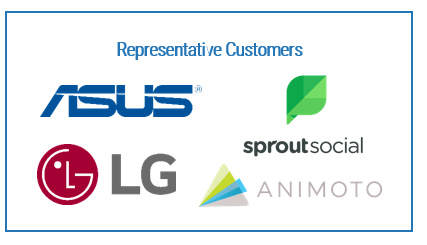
Stated Industry Specializations
- eCommerce
- Education
- Finance
- Software and IT
SoftwareReviews’ CSM Midmarket Vendor Ranking
(out of 8)
Likeliness to Recommend
- 1st (93%)
Plan to Renew
- 4th (92%)
Satisfaction That Cost Is Fair Relative to Value
- 5th (83%)
Strengths
- Product Strategy and Rate of Improvement (1st)
- Usability and Intuitiveness (1st)
- Breadth of Features (1st)
Areas to Improve
- Ease of Implementation (5th)
- Ease of IT Administration (5th)
- Ease of Customization (7th)
LiveChat
History
Founded 2002
2006 50% of company stock bought by Capital Partners.
2008 Capital Partners sells entire stake to Naspers.
2011 LiveChat buys back majority of stakeholder shares.
2013 Listed by Red Herring in group of most innovative companies across Europe.
2014 Listed on Warsaw Stock Exchange.
2019 HelpDesk is launched.
2020 Offered services for free to organizations helping mitigate the pandemic.
LiveChat’s HelpDesk solution for CSM is a relatively recent solution (2019) that is proving very popular for small to mid-sized businesses (SMBs) – especially across Western Europe. SoftwareReviews’ data shows that HelpDesk is well-rated for breadth of features, usability and intuitiveness, and rate of improvement. Indeed, LiveChat has won and been shortlisted for several awards over the past decade for customer feedback, innovation, and fast growth to IPO.
When shortlisting LiveChat’s HelpDesk, SMBs should be careful of scope creep. LiveChat offers a range of other solutions that are intended to work together. The LiveChat self-titled product is designed to integrate with HelpDesk to provide ticketing, email management, and chat management. Moreover, LiveChat’s AI-based ChatBot (for automated webchat) comes with additional cost (starting at $52 team/month).
Thomas Randall
Research Director, Info-Tech Research Group
| Team Plan | Enterprise |
|---|---|
|
|
*Pricing correct as of November 2022. Listed in USD and absent discounts.
See pricing on vendor’s website for latest information.
ManageEngine
Est. 1996 | India | Privately Owned
Bio
SupportCenter Plus is a web-based customer support software that lets organizations effectively manage customer tickets, their account and contact information, and their service contracts, and in the process provide a superior customer experience. ManageEngine is a division of Zoho.
Offices
- Americas: Brazil, Colombia, Mexico, US
- APAC: Australia, China, India, Japan, Singapore
- EMEA: Netherlands, Saudi Arabia, South Africa, UAE, UK
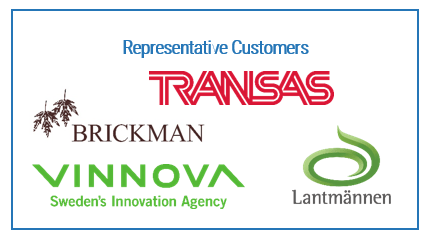
Stated Industry Specializations
- None stated but representative customers cover manufacturing, R&D, real estate, and transportation.
SoftwareReviews’ CSM Midmarket Vendor Ranking
(out of 8)
Likeliness to Recommend
- 6th (85%)
Plan to Renew
- 5th (91%)
Satisfaction That Cost Is Fair Relative to Value
- 6th (83%)
Strengths
- Ease of Customization (1st)
- Ease of Implementation (2nd)
- Ease of IT Administration (2nd)
Areas to Improve
- Quality of Features (4th)
- Usability and Intuitiveness (6th)
- Availability and Quality of Training (8th)
ManageEngine
History
Founded 1996
2002 Branches from Zoho to become division focused on IT management.
2004 Becomes an authorized MySQL Partner.
2009 Begins shift of offerings into the cloud.
2010 Tops 35,000 customers.
2011 Integration with Zoho Assist.
2015 Integration with Zoho Reports.
ManageEngine, as a division of Zoho, has its strengths in IT operations management (ITOM). SupportCenter thus scores well in our SoftwareReviews data for ease of customization, implementation, and administration. As ManageEngine is a frequently discussed low-cost vendor in the ITOM market, customers often get good scalability across IT, sales, and marketing teams. Although SupportCenter is aimed at the midmarket and is low cost, organizations have the benefit of ManageEngine’s global presence and backing by Zoho for viability.
However, because ManageEngine’s focus is ITOM, the breadth and quality of features for SupportCenter are not rated as well compared to its competitors. These features may be “good enough,” but usability and intuitiveness is not scored high. Organizations thinking about SupportCenter are recommended to identify their high-value use cases and perform user acceptance testing before adopting.
Thomas Randall
Research Director, Info-Tech Research Group
| Standard* | Pro* | Enterprise* |
|---|---|---|
|
|
|
*Pricing unavailable. Request quote.
See pricing on vendor’s website for latest information.
Zoho Desk
Est. 1996 | India | Privately Owned
Bio
Use the power of customer context to improve agent productivity, promote self-service, manage cross-functional service processes, and increase customer happiness. Zoho offers beautifully smart software to help you grow your business. With over 80 million users worldwide, Zoho's 55+ products (including Zoho Desk) aid your sales and marketing, support and collaboration, finance, and recruitment needs – letting you focus only on your business.
Offices
- Americas: Brazil, Colombia, Mexico, US
- APAC: Australia, China, India, Japan, Singapore
- EMEA: Netherlands, Saudi Arabia, South Africa, UAE, UK
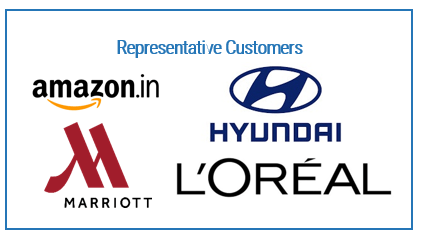
Stated Industry Specializations
- Covers an extremely wide range of industries, such as finance, education, government, healthcare, manufacturing, and retail.
SoftwareReviews’ CSM Midmarket Vendor Ranking
(out of 8)
Likeliness to Recommend
- 2nd (90%)
Plan to Renew
- 2nd (98%)
Satisfaction That Cost Is Fair Relative to Value
- 3rd (83%)
Strengths
- Breadth of Features (2nd)
- Quality of Features (3rd)
- Ease of Implementation (3rd)
Areas to Improve
- Business Value Created (5th)
- Ease of Data Integration (5th)
- Product Strategy and Rate of Improvements (5th)
Zoho Desk
History
Founded 1996
2001 Expands into Japan and shifts focus to SMBs.
2006 Zoho CRM is launched, alongside first Office suite.
2008 Reaches 1M users.
2009 Rebrands from AdventNet to Zoho Corp.
2011 Zoho Desk is built and launched.
2017 Zoho One, a suite of applications, is launched.
2020 Reaches 50M users.
Zoho Desk is one of the highest scoring CSM tool providers for likelihood to renew and recommend (98% and 90%, respectively). A major reason is that users receive a broad range of functionality for a lower-cost price model. There is also the capacity to scale with Zoho Desk as midmarket customers expand; companies can grow with Zoho and can receive high return on investment in the process.
However, while Zoho Desk can be used as a standalone CSM tool, there is danger of scope creep with other Zoho products. Zoho now has 50+ applications, all tied into one another. For Zoho Desk, customers may also lean into Zoho Assist (for troubleshooting customer problems via remote access) and Zoho Lens (for reality-based remote assistance, typically for plant machinery or servers). Consequently, customers should keep an eye on business value created if the scope of CSM grows wider.
Thomas Randall
Research Director, Info-Tech Research Group
| Standard | Pro | Enterprise |
|---|---|---|
|
|
|
*Pricing correct as of November 2022. Listed in USD and absent discounts.
See pricing on vendor’s website for latest information.
Summary of AccomplishmentSuccessful selection of a CSM tool
In this trends and buyer’s guide for CSM tool selection, we engaged in several activities to:
- Contextualize the CSM technology marketspace.
- Engage in a selection process for CSM tools.
The result:
- Understanding of key trends and differentiating features in the CSM marketspace.
- Determination of your organization’s customer service maturity (and thus if a standalone CSM tool is relevant).
- Identification of high-value use cases that CSM tools should successfully enable.
- Evaluation of major vendors in the CSM marketspace to discover the best-fitting provider.
- Procurement items to finalize selection process.
If you would like additional support, have our analysts guide you through an Info-Tech workshop or Guided Implementation
Contact your account representative for more information.
workshops@infotech.com
1-888-670-8889
Related Info-Tech Research
Governance and Management of Enterprise Software Implementation
- Being Agile will increase the likelihood of success.
The Rapid Application Selection Framework
- Application selection is a critical activity for IT departments. Implement a repeatable, data-driven approach that accelerates application selection efforts.
Build a Strong Technology Foundation for Customer Experience Management
- Design an end-to-end technology strategy to drive sales revenue, enhance marketing effectiveness, and create compelling experiences for your customers.
Bibliography
Capers, Zach. “How the Pandemic Changed Customer Attitudes Toward Biometric Technology.” GetApp, 21 Feb. 2022. Accessed Nov. 2022.
Gomez, Jenny. “The Good, the Bad, and the Ugly: A History of Customer Service.” Lucidworks, 15 Jul. 2021. Accessed Nov. 2022.
Hoory. “History of Customer Service: How Did It All Begin?” Hoory, 24 Mar. 2022. Accessed Nov. 2022.
Patel, Snigdha. “Top 10 Customer Service Technology Trends to Follow in 2022.” Reve Chat, 21 Feb. 2021. Accessed Nov. 2022.
RingCentral. “The 2020 Customer Communications Review: A Survey of How Consumers Prefer to Communicate with Businesses.” RingCentral, 2020. Accessed Nov. 2022.
Robinson-Yu, Sarah. “What is a Knowledgebase? How Can It Help my Business?” Vanilla, 25 Feb. 2022. Accessed Nov. 2022.
Salesforce. “The Complete History of CRM.” Salesforce, n.d. Accessed Nov. 2022.
Salesforce. “State of the Connected Customer.” 5th ed. Salesforce, 2022. Accessed Nov. 2022.
Sprinklr. “How AzkoNobel UK Reduced Response Times and Increased Engagement.” Sprinklr, 2021. Accessed Nov. 2022.
Vermes, Krystle. “Study: 70% of Marketers Using Advanced Personalization Seeing 200% ROI.” KoMarketing, 2 Jun. 2020. Accessed Nov. 2022.
Research Contributors and Experts

Colin Taylor
CEO
The Taylor Reach Group
Recognized as one of the leading contact/call center pioneers and experts, Colin has received 30 awards on two continents for excellence in contact center management and has been acknowledged as a leader and influencer on the topics of call/contact centers, customer service, and customer experience, in published rankings on Huffington Post, Call Center Helper, and MindShift. Colin was recognized as number 6 in the global 100 for customer service.
The Taylor Reach Group is a contact center, call center and customer experience (CX) consultancy specializing in CX consulting and call and contact center consulting, management, performance, technologies, site selection, tools, training development and center leadership training, center audits, benchmarking, and assessments.
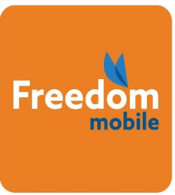
David Thomas
Customer Service Specialist
Freedom Mobile
David Thomas has both managerial and hands-on experience with delivering quality service to Freedom Mobile customers. With several years being involved in training customer support and being at the forefront of retail during the pandemic, David has witnessed first-hand how to incentivize staff with the right metrics that create positive experiences for both staff and customers.
Freedom Mobile Inc. is a Canadian wireless telecommunications provider owned by Shaw Communications. It has 6% market share of Canada, mostly in urban areas of Ontario, British Columbia, and Alberta. Freedom Mobile is the fourth-largest wireless carrier in Canada.
A special thanks to three other anonymous contributors, all based in customer support and contact center roles for Canada’s National Park Booking Systems’ software provider.
